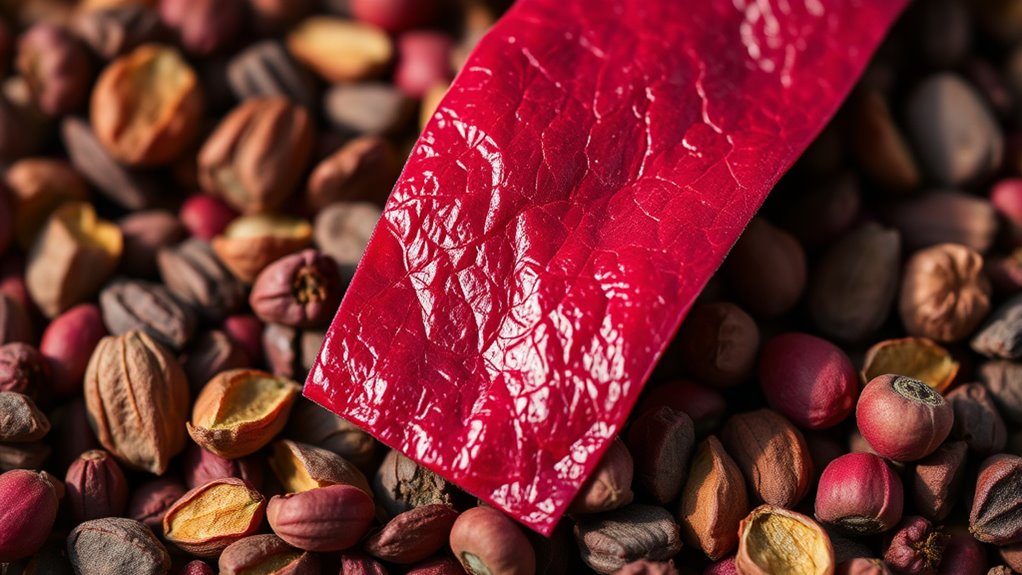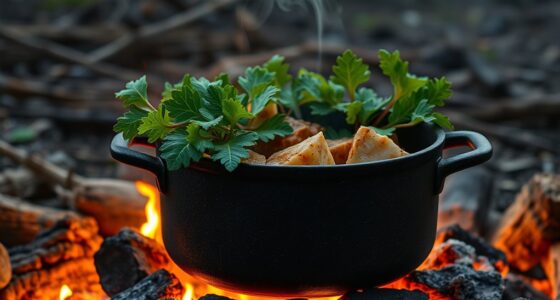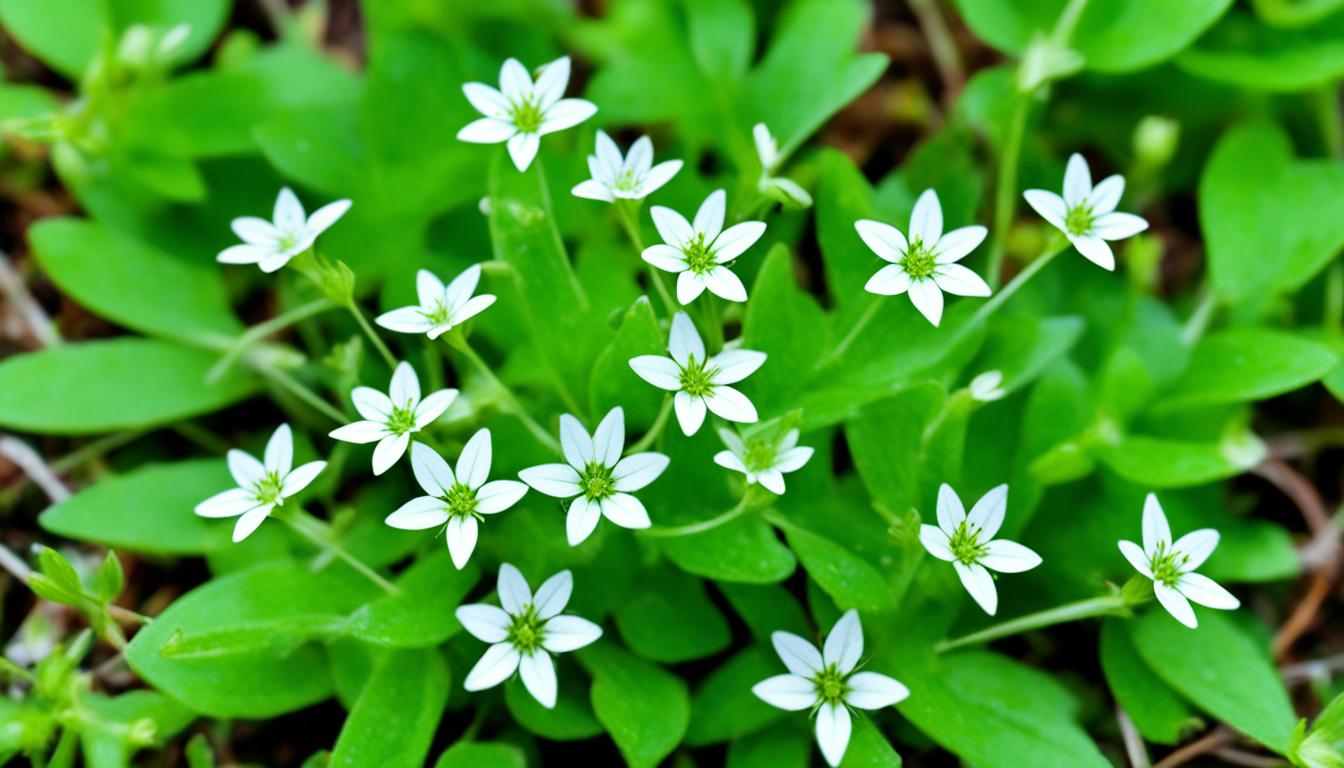Rosehip fruit leather is an ideal backpacking snack because it’s lightweight, portable, and packed with vitamin C and antioxidants that boost your immune system and energy levels on the trail. It’s easy to personalize with flavors like citrus or cinnamon, making it both tasty and nutritious. Plus, making your own at home guarantees quality and freshness. If you want tips on choosing, preparing, or storing it, explore more for all the expert advice you need.
Key Takeaways
- Lightweight, portable, and easy to pack, making it ideal for backpacking snacks.
- Rich in vitamin C and antioxidants to support immune health during outdoor activities.
- Natural flavor and chewy texture provide sustained energy and curb hunger on hikes.
- Homemade or store-bought options ensure freshness, minimal additives, and customizable flavors.
- Proper dehydration and packaging maintain quality, flavor, and shelf life for outdoor adventures.
Benefits of Choosing Rosehip Fruit Leather for Hikes
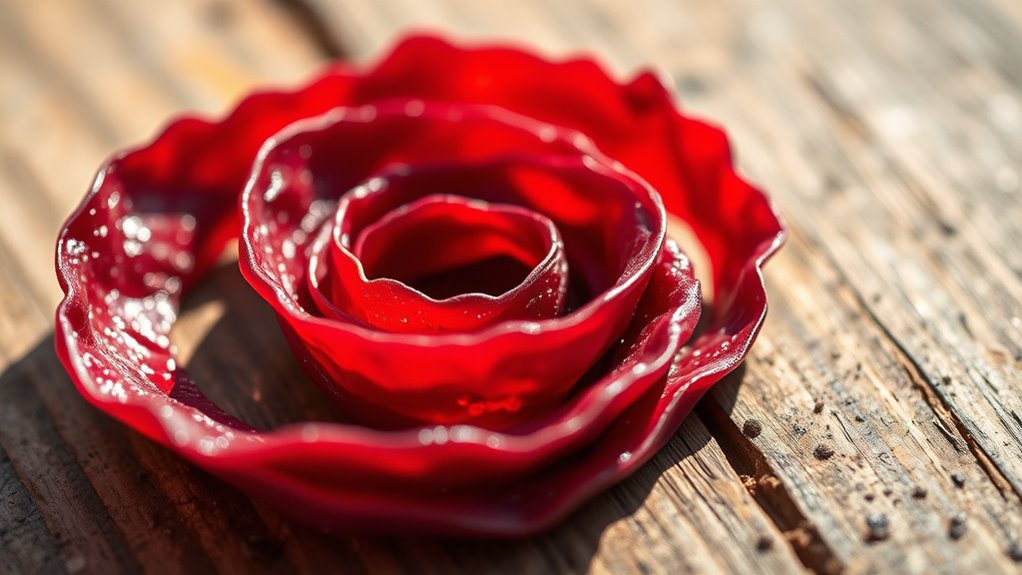
Rosehip fruit leather is an excellent snack to bring on hikes because it’s lightweight, portable, and packed with nutrients. Its nutritional benefits include high levels of vitamin C, antioxidants, and fiber, helping you stay energized and support your immune system during outdoor adventures. Plus, choosing rosehip fruit leather supports sustainability practices since it’s often made from locally sourced or organic ingredients, reducing environmental impact. By selecting this eco-friendly snack, you contribute to sustainable agriculture and waste reduction efforts. Its natural sweetness and concentrated nutrients make it an ideal, healthful option to satisfy your hunger without adding bulk to your pack. Overall, rosehip fruit leather offers a nutritious, eco-conscious choice that keeps you fueled and ready for the trail. Incorporating natural ingredients enhances the health benefits and aligns with eco-friendly practices.
How to Make Your Own Rosehip Fruit Leather at Home

Ever wondered how to create a delicious, nutritious snack right in your own kitchen? Making rosehip fruit leather is simple and rewarding. Start by understanding the cultural significance of rosehips, used for centuries in traditional remedies. Proper harvesting techniques ensure you pick ripe, nutrient-rich hips without damaging plants. Wash and deseed the fruit, then blend it into a smooth puree. Spread the mixture evenly on a parchment-lined baking sheet. Dry it in a low-temperature oven or dehydrator until leathery. Dehydration methods can influence the texture and shelf life of your fruit leather. Here’s a quick guide:
| Step | Action |
|---|---|
| 1 | Harvest ripe rosehips |
| 2 | Wash and deseed |
| 3 | Blend into puree |
| 4 | Spread on tray |
| 5 | Dehydrate until leathery |
Enjoy your homemade snack packed with history and health.
Essential Ingredients and Equipment for Preparation
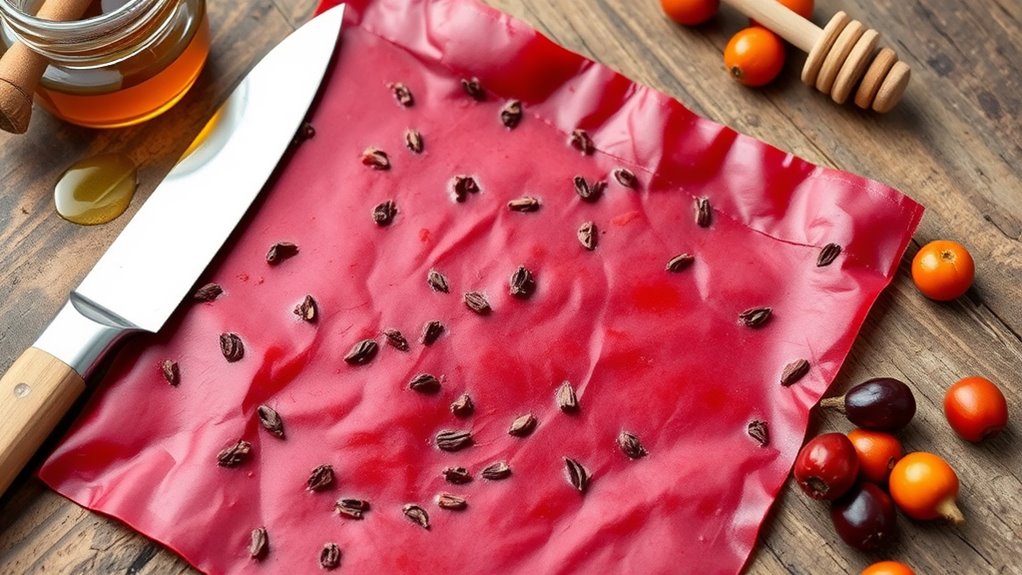
To make your rosehip fruit leather, you’ll need to choose the right ingredients, like ripe rosehips and natural sweeteners. You should also gather essential equipment such as a blender, drying tray, and parchment paper. Having these items ready guarantees a smooth and efficient preparation process. Incorporating proper food preparation techniques can help ensure the best flavor and texture in your fruit leather.
Essential Ingredients Selection
Choosing the right ingredients and equipment is vital for making high-quality fruit leather. Start with high-quality dried fruit, like dried rosehips, to guarantee vibrant flavor and good texture. Fresh fruit can be used, but dried fruit offers convenience and consistency. Select dried fruit free of added sugars or preservatives for a healthier snack. When it comes to ingredients, consider adding natural sweeteners like honey or agave to enhance flavor if needed. For equipment, use a blender or food processor to purée the fruit smoothly. Keep in mind that proper snack packaging is indispensable for storing your finished fruit leather, helping it stay fresh and portable for backpacking. Focus on quality ingredients and suitable packaging to create an enjoyable, durable treat.
Necessary Equipment Checklist
Preparing rosehip fruit leather requires gathering the right equipment to guarantee smooth processing and a high-quality final product. You’ll need a blender or food processor to puree the soaked rosehips, ensuring a smooth consistency for even drying. A fine mesh strainer or cheesecloth is essential for removing seeds and pulp, creating a uniform paste. To maintain snack portability, use a spatula or scraper to spread the mixture evenly on a dehydrator tray or baking sheet. A dehydrator is ideal for consistent drying, but an oven works if you keep the temperature low. Keep trail hydration in mind—having a water bottle nearby helps you stay refreshed. With the right tools, you’ll produce delicious, portable snacks perfect for backpacking adventures.
Step-by-Step Instructions for Crafting the Perfect Snack
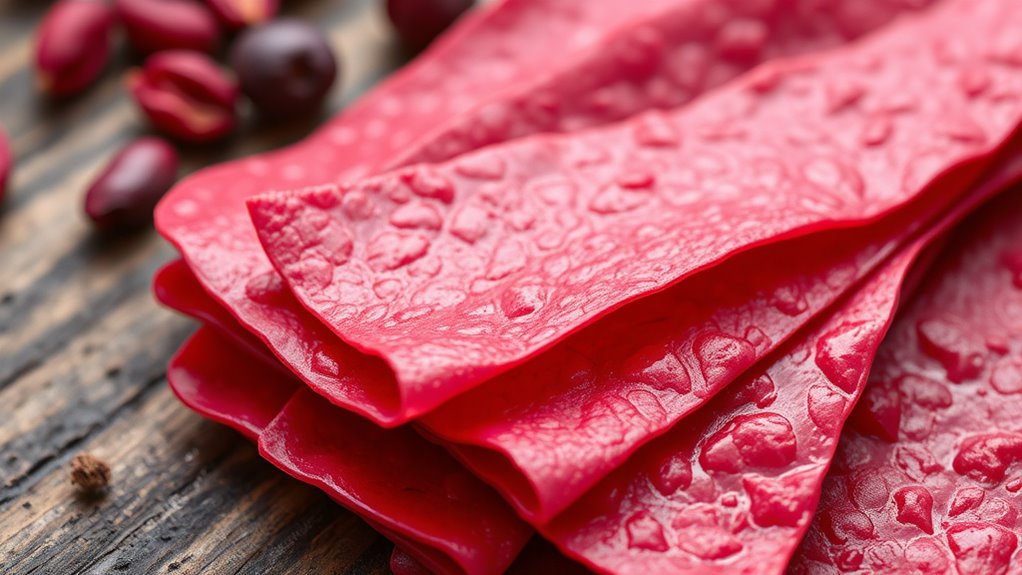
Creating the perfect rosehip fruit leather starts with selecting ripe, high-quality rosehips. Begin by washing and removing stems, then simmer them to soften. Puree the softened rosehips until smooth. To guarantee ideal fruit preservation and flavor, strain out seeds and skins. Incorporate organic methods to enhance the flavor and nutritional profile of your fruit leather. Spread the puree evenly on a parchment-lined baking sheet or dehydrator tray. Use the following chart to guide your process:
| Step | Action |
|---|---|
| 1 | Prepare rosehips by washing. |
| 2 | Simmer until soft. |
| 3 | Puree until smooth. |
| 4 | Strain to remove seeds/skins. |
| 5 | Spread evenly on tray. |
Dehydrate at low heat until leathery, then cut into strips. This method guarantees a portable, fruit-preservation snack perfect for backpacking.
Tips for Packing and Carrying Rosehip Fruit Leather on Trails

To keep your rosehip fruit leather fresh and portable on the trail, start by wrapping it tightly in wax paper or parchment, then place it in a resealable plastic bag or airtight container. Using appropriate packaging materials prevents moisture and air exposure, helping maintain its texture and flavor. When carrying your snack, employ effective carrying techniques like stacking multiple pieces with parchment between layers to prevent sticking or tearing. Consider using a small, durable container or a dedicated snack bag to keep everything organized and protected from rough handling. Avoid overpacking fragile items, and position the fruit leather where it won’t get squished. Proper packaging materials and carrying techniques ensure your rosehip fruit leather stays fresh, intact, and ready to enjoy during your outdoor adventure. Additionally, incorporating specialized packaging helps extend shelf life and preserve flavor during longer trips.
Store-Bought Options and How to Select Quality Products

When choosing store-bought rosehip fruit leather, check the ingredient labels to guarantee transparency and avoid unnecessary additives. Pay attention to the dryness and texture—quality products should be firm yet not overly brittle. Opt for organic options whenever possible to ensure you’re getting a product free from synthetic preservatives and fillers. Additionally, consider the Vetted – Halloween Product Reviews to find trusted brands known for quality.
Ingredient Transparency and Labels
Choosing store-bought rosehip fruit leather requires careful attention to ingredient labels, as manufacturers vary widely in transparency. You want to guarantee ingredient sourcing is clear, with minimal added sugars or preservatives. Look for products that prioritize label accuracy, clearly listing all ingredients without vague terms like “natural flavors” or “artificial additives.” This transparency is crucial for maintaining textile art integrity and ensuring you know exactly what you’re consuming and avoid unwanted fillers.
- Check for certifications or seals indicating quality standards
- Read the ingredient list thoroughly for whole fruit content
- Be cautious of overly long or vague ingredient lists that hide fillers
Dryness and Texture Quality
Examining the dryness and texture of store-bought rosehip fruit leather helps guarantee you pick a high-quality product. Look for a leather that retains some moisture, ensuring it’s not overly dry or brittle. Proper moisture retention results in a chewy texture that’s satisfying without being sticky or overly tough. When you handle it, it should feel slightly pliable, not crumbly or hard. A good quality fruit leather balances dryness with flexibility, indicating it was dried properly without losing essential moisture. Avoid products that are excessively dry or excessively sticky, as these often compromise flavor and texture. Choosing a leather with consistent, even texture ensures a pleasant snacking experience on your backpacking trip and confirms you’ve selected a well-made, high-quality product. Additionally, filtering quality in manufacturing processes can greatly influence the final product’s texture and moisture retention.
Organic and Additive Content
Opting for organic rosehip fruit leather guarantees you avoid exposure to unnecessary chemicals and additives that can diminish flavor and nutritional value. When selecting store-bought options, check labels carefully to ensure they contain minimal ingredients and no artificial preservatives. Look for products that specify dairy free options, especially if you have sensitivities, and consider gluten free considerations if you have celiac disease or gluten intolerance. Choosing organic also supports sustainable farming practices and ensures higher quality ingredients. Be aware that some fruit leathers may contain added sugars or flavorings that mask natural taste. To ensure you’re getting a wholesome snack, prioritize products with transparent ingredient lists and certifications. Remember, quality matters to maximize flavor, nutrition, and your overall backpacking experience.
Creative Variations and Flavors to Enhance Your Snack
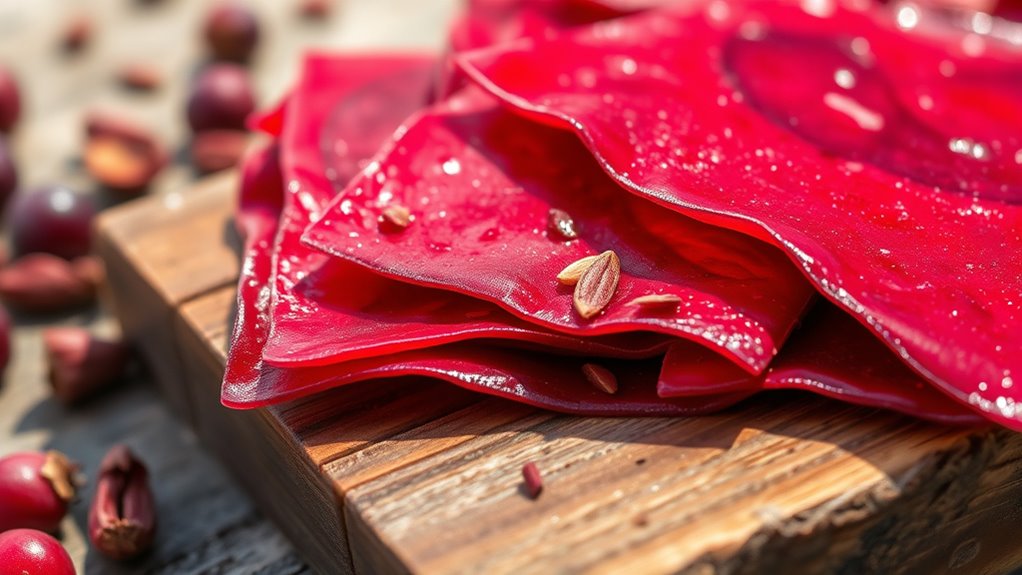
Adding creative variations and flavors to your rosehip fruit leather can turn a simple snack into a delightful tasting experience. Experiment with flavor combinations like citrus zest, cinnamon, ginger, or vanilla to add depth and complexity. You can also incorporate dried berries, mint leaves, or a hint of chili for unique twists. To preserve these flavors, use preservation techniques such as proper dehydration and airtight storage, which help maintain freshness and prevent spoilage. Mixing in different ingredients before drying ensures each batch offers new taste sensations. Be mindful of balancing sweetness and tartness to suit your preferences. Incorporating ingredients rich in antioxidants can further boost the health benefits of your snack. These creative variations make your backpacking snacks more enjoyable, energizing, and tailored to your adventurous palate.
Frequently Asked Questions
How Long Does Homemade Rosehip Fruit Leather Typically Last?
Your homemade fruit leather typically lasts about 1 to 2 weeks when stored properly. To maximize shelf life, keep it in an airtight container or vacuum-sealed bag, and store it in a cool, dark place or the refrigerator. Proper storage tips help prevent mold and spoilage, ensuring you enjoy your homemade treat longer. If you want it to last even longer, consider freezing it, which can extend freshness for several months.
Can I Substitute Dried Rosehips With Fresh Ones?
When considering fresh vs dried rosehips for your fruit leather, ask yourself if you want more moisture, easier storage, or a softer texture. Substituting fresh rosehips offers benefits like higher water content, vibrant flavor, and natural juiciness, but it also means adjusting the recipe to account for extra moisture. You can use fresh or dried based on your preference, but remember, dried rosehips provide convenience, longer shelf life, and concentrated flavor.
Is Rosehip Fruit Leather Suitable for People With Allergies?
When considering allergy considerations, you should check ingredient substitutions carefully before trying rosehip fruit leather. While generally safe, some people might have sensitivities to rosehips or added ingredients like preservatives or sweeteners. Always read labels thoroughly and consult with your healthcare provider if you’re unsure about potential allergic reactions. This way, you can enjoy your snacks safely without risking an allergy attack.
What Are the Best Storage Containers for Preserving Freshness?
Imagine packing your favorite snacks and wanting them to stay fresh. You should use airtight containers, like glass jars with tight lids, to prevent moisture and air from spoiling your treats. Reusable wraps are also great for smaller items or snacks. For example, storing rosehip fruit leather in an airtight container keeps it chewy and fresh longer. Both options help preserve flavor and texture effectively.
How Do I Prevent Mold During Storage?
To prevent mold during storage, you should focus on mold prevention and follow proper storage tips. Keep your items in airtight containers to reduce moisture exposure, as mold thrives in humid environments. Confirm your storage area is cool, dry, and well-ventilated. Regularly check your stored items for signs of mold, and remove any affected portions immediately. Properly sealing and maintaining a dry environment are key to keeping your food fresh and mold-free.
Conclusion
Now that you know how to make and enjoy rosehip fruit leather, you’re all set to hit the trail with a nutritious, homemade snack in hand. It’s a win-win situation—you get to control the ingredients and satisfy your sweet tooth naturally. Plus, packing this snack is a breeze, so don’t be surprised if it becomes your go-to trail treat. Remember, a good thing is worth its weight in gold, so enjoy every bite!

